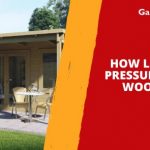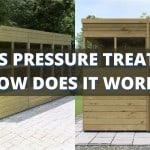Jump to:
Exposure to outdoor elements and harsh weather can take a toll on wooden garden buildings over time. Thus, these structures will need some kind of treatment to withstand such external factors. You have three options: pressure treatment, dip treatment and spray treatment. But which treatment should you choose?
What Makes Treating Wood Necessary?
Wood, in its natural form, can last a long time outside, but that doesn’t mean it’s impenetrable. As a biodegradable material, timber can break down when exposed to moisture, sunlight, and rain. If left untreated, it will eventually succumb to rot; not only that, but insects, mould, and fungi will snack on it!
That’s why treating it is recommended, especially for wooden structures like garden rooms that are likely to be used for storage or relaxation. After all, the only way to protect wood, like any other material, is through the right treatment—no exceptions.
The good thing is that most wooden garden buildings are sold pre-treated using three methods.
Pressure Treated
Wood must undergo a lengthy process called pressure treatment, also known as vacuum pressure impregnation, to be considered pressure treated. We know there are many pressure-related terms to take in, but we’ll break them down simply for you.
Pressure treatment involves cutting and drying wood and placing it in an airtight steel cylinder. A vacuum removes the air, and chemical preservatives are added. The vacuum then extracts any excess liquid. In a low-pressure environment (inside the cylinder), the wood absorbs the preservative deep into the grain. This ensures thorough treatment inside and out.
When it comes to garden buildings, e.g., pressure treated sheds and pressure treated log cabins, manufacturers handle the work. Companies and manufacturers often offer this treatment as a standard for their products—with some providing it as an option. This means they complete the pressure treatment process before delivery. However, this adds to the cost, and dispatch might take longer, ranging from 2 to 8 weeks, depending on availability, order demand, and your location.
A pressure treated garden building might have a higher upfront cost, but it’ll definitely last longer and save you the hassle of annual maintenance. Trusted retailers like Garden Buildings Direct offer a 15-year anti-rot guarantee, making it a smart investment that will save you money in the long run.
Dip Treated
Dip treating wood is a less time-consuming process than pressure treating. How it works is more straightforward, too: timber in bulk is dipped into a tank with either a water-based or solvent-based preservative until it’s fully absorbed by the wood.
Dip treatment is quick and cost-effective—and you can even do it yourself if you plan to build your own summer house using treated lumber, provided you have the expertise. However, it’s not as durable and long-lasting as pressure treatment and will require more maintenance in the form of annually topping up the paint.
Spray Treated
Many wooden sheds and other buildings are offered with a factory spray treatment. This is a quick and cost-effective way to protect wood for a short time, usually just for the duration of its transit after sale. Ultimately, this protection will only last for a short time and will require you to paint the building with a treatment after installation, followed by annual maintenance, in order to stay healthy.
Round-up
So, which treatment process meets your demand best? Dip treating is cheaper but requires regular maintenance. Pressure treatment is more expensive, but the results are superior. We recommend investing in a pressure-treated garden building to save you the hassle of applying the treatment yourself and the upkeep costs.
Up next on your reading list: What Is Pressure Treatment and How Does It Protect Wood?










